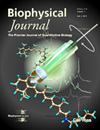Single-Molecule FRET and Tracking of Transfected Biomolecules in Living Cells.
IF 3.1
3区 生物学
Q2 BIOPHYSICS
引用次数: 0
Abstract
Proteins and DNA in cells exhibit different conformational states, which are influenced by dynamic interactions with other biomolecules. All these interactions are affected by the molecules' localization within the cell, i.e., their compartmentalization. Such, in cellula, compartment-specific dynamics is difficult to measure, because of limitations in instrumentation, autofluorescence of cells, and the necessity to track diffusing molecules. Here, we present a bottom-up engineering approach, which allows us to track transfected proteins in cellula and to analyze time-resolved single-molecule FRET efficiencies. This has been achieved by alternating laser excitation (ALEX) based dual-channel (donor and FRET, acceptor) tracking with a HILO microscope. We validate our strategy by characterizing long-term static FRET traces of customized DNA with known dye positions. We utilize two different transfection strategies, namely Microinjection (physical) and a transfection mediated by the toxin Streptolysin-O (biological). By comparing in vitro and in cellula measurements we show that the cellular environment in this case changes the FRET efficiency by about 25%. In addition, we evaluate single-molecule FRET traces for the heat shock protein Hsp90 in cellula. The obtained FRET efficiency distribution is largely consistent with known Hsp90 structures and in vitro distributions, but also shows some clear differences. Altogether, we show that FRET-TTB (Förster Resonance Energy Transfer-Tracking of Transfected Biomolecules) opens the path to study protein state changes of transfected biomolecules in living cells, including their time-resolved cellular localization.活细胞中转染生物分子的单分子FRET和跟踪。
细胞中的蛋白质和DNA表现出不同的构象状态,这些构象状态受到与其他生物分子动态相互作用的影响。所有这些相互作用都受到分子在细胞内定位的影响,即它们的区隔化。因此,在细胞中,由于仪器的限制,细胞的自身荧光,以及跟踪扩散分子的必要性,室特异性动力学很难测量。在这里,我们提出了一种自下而上的工程方法,使我们能够跟踪细胞中转染的蛋白质,并分析时间分辨的单分子FRET效率。这是通过使用HILO显微镜进行基于交替激光激发(ALEX)的双通道(供体和FRET,受体)跟踪来实现的。我们通过描述具有已知染料位置的定制DNA的长期静态FRET痕迹来验证我们的策略。我们使用两种不同的转染策略,即显微注射(物理)和由毒素Streptolysin-O介导的转染(生物)。通过比较体外和细胞内的测量结果,我们发现在这种情况下,细胞环境改变了FRET效率约25%。此外,我们评估了细胞中热休克蛋白Hsp90的单分子FRET痕迹。所得的FRET效率分布与已知的Hsp90结构和体外分布基本一致,但也有一些明显的差异。总之,我们发现FRET-TTB (Förster Resonance Energy Transfer-Tracking of转染的生物分子)为研究转染的生物分子在活细胞中的蛋白质状态变化,包括它们的时间分辨率细胞定位开辟了途径。
本文章由计算机程序翻译,如有差异,请以英文原文为准。
求助全文
约1分钟内获得全文
求助全文
来源期刊

Biophysical journal
生物-生物物理
CiteScore
6.10
自引率
5.90%
发文量
3090
审稿时长
2 months
期刊介绍:
BJ publishes original articles, letters, and perspectives on important problems in modern biophysics. The papers should be written so as to be of interest to a broad community of biophysicists. BJ welcomes experimental studies that employ quantitative physical approaches for the study of biological systems, including or spanning scales from molecule to whole organism. Experimental studies of a purely descriptive or phenomenological nature, with no theoretical or mechanistic underpinning, are not appropriate for publication in BJ. Theoretical studies should offer new insights into the understanding ofexperimental results or suggest new experimentally testable hypotheses. Articles reporting significant methodological or technological advances, which have potential to open new areas of biophysical investigation, are also suitable for publication in BJ. Papers describing improvements in accuracy or speed of existing methods or extra detail within methods described previously are not suitable for BJ.
 求助内容:
求助内容: 应助结果提醒方式:
应助结果提醒方式:


